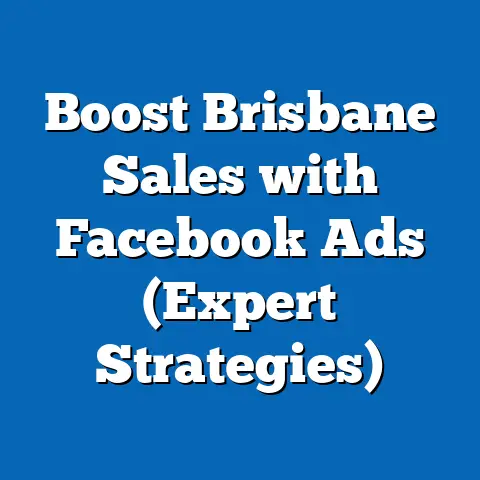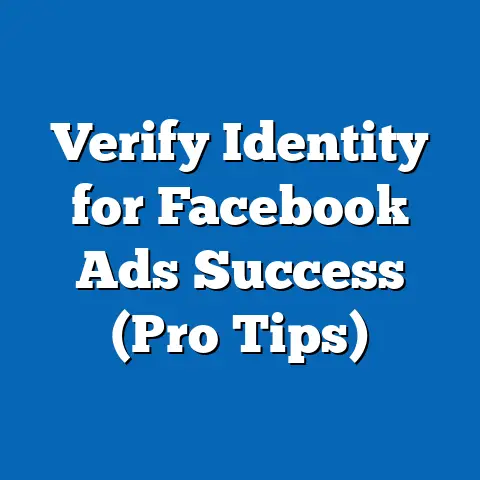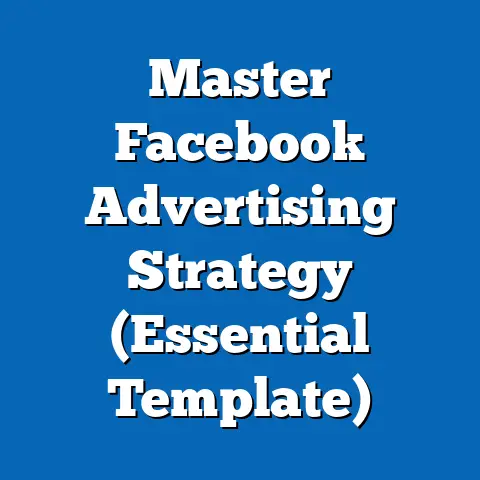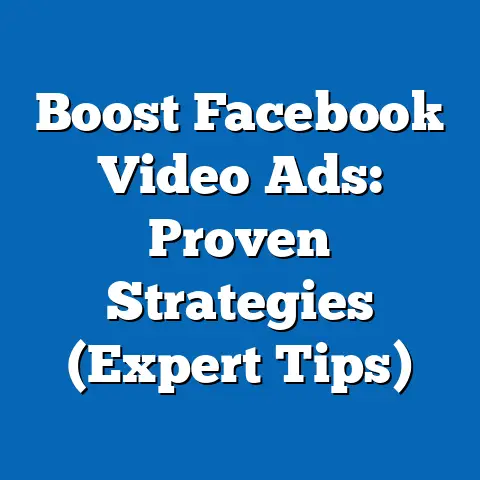Maximize Engagement with Optimal Facebook Ad Length (Expert Tips)
Facebook ads have become an indispensable tool for businesses aiming to thrive in the digital landscape. I’ve seen firsthand how a well-crafted ad can catapult a small business into the spotlight, driving traffic, generating leads, and boosting sales. But let’s face it, in today’s fast-paced digital world, attention spans are shorter than ever. That’s where the art of crafting the perfect Facebook ad length comes into play. Too long, and you risk losing your audience. Too short, and you might not convey your message effectively.
Think of it like this: you’re walking through a crowded street, and dozens of people are trying to grab your attention. What makes you stop and listen to one over the others? It’s the clarity, the relevance, and the brevity of their message. The same principle applies to Facebook ads. The goal of this article is to equip you with expert tips on determining and utilizing the optimal Facebook ad length to captivate your audience and drive maximum engagement. I’ll walk you through the nuances of different ad types, the psychology of attention, and how to measure your results to ensure your ads are hitting the mark. Let’s dive in!
Understanding Facebook Ad Functionality
Before we delve into the specifics of ad length, it’s crucial to understand the fundamental workings of Facebook ads. I often tell my clients that running a successful Facebook ad campaign is like conducting an orchestra. Each instrument (ad type, targeting, budget) needs to be in harmony to create a masterpiece.
Facebook offers a variety of ad types, each designed to serve different objectives:
- Image Ads: These are the simplest form, featuring a single image or video with accompanying text.
- Video Ads: Engaging and dynamic, video ads can capture attention and tell a story more effectively than static images.
- Carousel Ads: Perfect for showcasing multiple products or features, carousel ads allow users to swipe through a series of images or videos.
- Collection Ads: Designed for e-commerce, collection ads display a catalog of products in a visually appealing format.
- Lead Ads: Streamline the lead generation process by allowing users to submit their information directly within the Facebook platform.
- Instant Experience Ads: A full-screen, mobile-optimized experience that opens when someone clicks on your ad, providing an immersive way to engage with your brand.
The beauty of Facebook’s ad platform lies in its sophisticated algorithms. These algorithms analyze user behavior, interests, and demographics to deliver your ads to the most relevant audience. Engagement metrics, such as click-through rates (CTR), likes, shares, and comments, play a pivotal role in determining ad visibility. The more engagement your ad receives, the higher its relevance score, which in turn leads to lower costs and wider reach. I’ve seen ads with high engagement scores achieve significantly better results, even with smaller budgets.
Ad length is inextricably linked to Facebook’s user behavior and content consumption patterns. Users are constantly bombarded with information on their newsfeeds, scrolling through posts at lightning speed. If your ad is too lengthy or convoluted, it risks being overlooked. Conversely, if it’s too short and lacks substance, it may fail to capture their attention. Finding the sweet spot is key.
Key Takeaway: Familiarize yourself with the different types of Facebook ads and understand how the platform’s algorithms prioritize engagement. This knowledge will form the foundation for crafting ads of optimal length.
The Psychology of Attention
Understanding the psychology of attention is like having a secret weapon in your marketing arsenal. I’ve often found that the most successful ads are those that tap into the underlying motivations and behaviors of the target audience.
In today’s digital age, attention spans are dwindling. Studies have shown that the average human attention span has decreased from 12 seconds in 2000 to just 8 seconds today – shorter than that of a goldfish! This means you have a fleeting moment to grab someone’s attention and make a lasting impression.
Statistics on user engagement with different ad lengths paint a clear picture:
- Shorter video ads (15-30 seconds) tend to have higher completion rates compared to longer videos.
- Concise ad copy (under 90 characters) often leads to higher click-through rates, especially on mobile devices.
- Visually appealing images and videos are crucial in capturing attention within the first few seconds.
I remember working with a client who insisted on using long-form video ads to showcase their product. Despite the high production quality, the ads performed poorly. After analyzing the data, we realized that most viewers were dropping off within the first 10 seconds. We then created a series of shorter, more targeted video ads, and the results were remarkable. Engagement soared, and the client saw a significant increase in sales.
The ’80/20 Rule,’ also known as the Pareto Principle, suggests that 80% of your results come from 20% of your efforts. In the context of Facebook ads, this means focusing on the most impactful elements of your message. Identify the core value proposition of your product or service and communicate it clearly and concisely. Avoid unnecessary jargon or fluff that could distract from the main point.
Key Takeaway: Respect your audience’s time and attention by crafting concise, visually appealing ads that deliver your message effectively within a short timeframe. Focus on the 20% of your message that will drive 80% of your results.
Optimal Length for Different Ad Types
The ideal ad length varies depending on the type of Facebook ad you’re using. Each ad type has its own unique characteristics and best practices. Let’s break down the optimal length for each:
Image Ads
Image ads are a staple of Facebook advertising, known for their simplicity and versatility. The key to success with image ads lies in the synergy between the visual and the text.
- Optimal Video Length: Aim for videos that are between 15 and 60 seconds long. Shorter videos tend to have higher completion rates, while longer videos can be used for storytelling or product demonstrations.
- Key Messaging Tips: Start with a hook that grabs attention within the first few seconds. Use visuals and sound to create an emotional connection with your audience. Include a clear call to action at the end of the video.
- Example: A fitness brand might create a 30-second video ad showcasing a quick workout routine with the tagline “Get Fit in Minutes!” and a call to action to visit their website for more workouts.
Carousel Ads
Carousel ads are perfect for showcasing multiple products, features, or benefits in a single ad unit. They allow users to swipe through a series of images or videos, each with its own headline, description, and link.
Key Takeaway: Tailor your ad length to the specific ad type you’re using. Keep image ads concise, video ads engaging, and carousel ads informative and visually appealing.
Crafting Your Message
Crafting a concise and compelling message is an art form. I’ve learned that the most effective messages are those that resonate with the audience on an emotional level while delivering a clear and concise value proposition.
Here are some expert tips on how to craft messages that fit within the recommended lengths:
- Know Your Audience: Understand their needs, interests, and pain points. Use language that resonates with them and speaks directly to their concerns.
- Focus on Benefits, Not Features: Highlight the benefits of your product or service rather than simply listing its features. Explain how it will solve their problems or improve their lives.
- Use Strong Visuals: Images and videos are powerful tools for capturing attention and conveying your message quickly. Choose visuals that are relevant, high-quality, and emotionally engaging.
- Write Compelling Headlines: Your headline is the first thing people will see, so make it count. Use strong verbs, intriguing questions, or benefit-driven statements to grab their attention.
- Keep it Concise: Every word should serve a purpose. Eliminate unnecessary jargon or fluff that could distract from the main point.
- Include a Clear Call to Action: Tell people what you want them to do. Use action-oriented language and make it easy for them to take the next step.
A/B testing is your best friend when it comes to finding what resonates best with your audience. I always advise my clients to test different lengths and variations of their ad copy to see what performs best. Here’s how to do it:
- Create Multiple Versions: Write two or more versions of your ad copy with different lengths and messaging.
- Run the Ads Simultaneously: Use Facebook’s A/B testing feature to run the ads simultaneously, targeting the same audience.
- Track the Results: Monitor the performance of each ad, paying attention to metrics like click-through rates, conversion rates, and cost per acquisition.
- Analyze the Data: Determine which version performed best and use those insights to refine your messaging.
Key Takeaway: Craft your message with precision, focusing on the benefits, using strong visuals, and including a clear call to action. Use A/B testing to fine-tune your ad copy and find what resonates best with your audience.
Measuring Engagement Outcomes
Measuring engagement outcomes is like reading a map to navigate your Facebook ad campaigns. I’ve found that tracking the right metrics and analyzing the data is essential for optimizing your ads and achieving your desired results.
Facebook Ads Manager provides a wealth of data on your ad performance. Here are some key metrics to focus on when evaluating the success of your ad length:
- Impressions: The number of times your ad was displayed.
- Reach: The number of unique people who saw your ad.
- Click-Through Rate (CTR): The percentage of people who clicked on your ad after seeing it.
- Engagement Rate: The percentage of people who liked, shared, or commented on your ad.
- Conversion Rate: The percentage of people who completed a desired action (e.g., made a purchase, filled out a form) after clicking on your ad.
- Cost Per Acquisition (CPA): The cost of acquiring one customer or lead through your ad campaign.
When evaluating the success of your ad length, pay close attention to the following:
- CTR: A high CTR indicates that your ad is capturing attention and resonating with your audience. If your CTR is low, consider shortening your ad copy or using more compelling visuals.
- Engagement Rate: A high engagement rate suggests that your ad is sparking interest and encouraging interaction. If your engagement rate is low, try asking a question, running a contest, or using emotionally engaging content.
- Conversion Rate: A high conversion rate means that your ad is driving desired actions. If your conversion rate is low, ensure that your landing page is relevant to your ad and that the call to action is clear and easy to follow.
Based on your data insights, you can adjust your ad length to improve performance. Here’s how:
- Shorten Your Ad Copy: If your CTR is low, try shortening your ad copy to make it more concise and attention-grabbing.
- Experiment with Different Visuals: If your engagement rate is low, try using different images or videos to see what resonates best with your audience.
- Refine Your Targeting: If your conversion rate is low, ensure that you’re targeting the right audience with your ad.
Key Takeaway: Track your engagement metrics, analyze the data, and adjust your ad length based on your findings. Use data-driven insights to optimize your ads and achieve your desired results.
Conclusion
In the dynamic world of Facebook advertising, understanding and utilizing the optimal ad length is crucial for maximizing engagement and achieving your marketing goals. I’ve walked you through the importance of understanding Facebook’s ad functionality, the psychology of attention, and the ideal lengths for different ad types. I’ve also shared expert tips on crafting concise and compelling messages and measuring your results to ensure your ads are hitting the mark.
Remember, the key is to respect your audience’s time and attention by delivering your message effectively within a short timeframe. By following these guidelines and continuously testing and refining your approach, you can create Facebook ads that capture attention, drive engagement, and generate tangible results.
Now it’s your turn. Take these tips and implement them in your next Facebook ad campaign. Experiment with different lengths, visuals, and messaging to see what works best for your audience. Track your results, analyze the data, and make adjustments as needed. I’m confident that by mastering the art of optimal Facebook ad length, you can unlock the full potential of your advertising efforts and achieve unprecedented success. Go ahead, give it a try, and watch your engagement soar!






